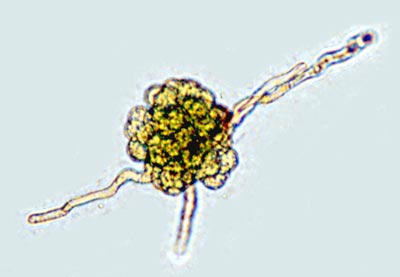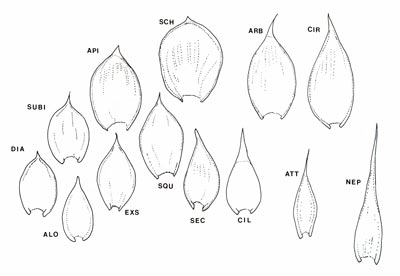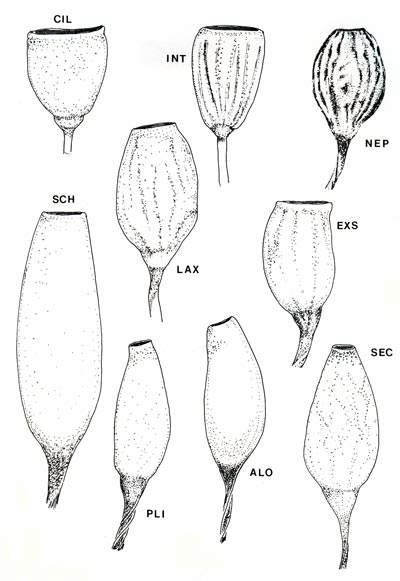HEDWIGIACEAE
Taxonomic treatment
Contents of this website
|
|
|
| HEDWIGIACEAE Schimper |
Plants small to medium [or large], creeping primary stems, secondary branches becoming erect, inclined or horizontal to form simple or sympodialy branched fronds, dark or green. Stem cortex several layers of orange-brown, thick walled cells, central strand not differentiated; paraphyllia absent; pseudoparaphyllia filamentous, uniseriate to foliose; rhizoids mostly restricted to stoloniferous branches, at abaxial base of leaves, reddish brown, straight, branching distally. Axillary hairs 2--3 per axil, 1--2 short brownish basal cells and 1--4 longer hyaline cells. Stem leaves on primary modules, distant, adpressed dry, concave, tips erect wet, ovate to oblong, base ovate, apex acute or long acuminate, ecostate; medium sized; margin plane or revolute at base, entire to crenulate [or serrate] distally; proximal lamina cells long rectangular, yellow, thick walled, porose; medial lamina cells short rectangular, sinuose, with one or two papillae over the cell lumen; distal laminal cells shorter; alar cells little differentiated or in several rows up margin, oblate or quadrate. Branch leaves concave, narrow ovate-acuminate and long.
Sexual condition autoicous. Perigonia numerous when present, on stem and branches, with scale-like leaves, uniseriate paraphyses, yellow, 8--12 antheridia. Perichaetia terminal on stem; perichaetial leaves 6--8, outer scale-like, inner erect, ovate-acuminate, gradually narrowed to long acuminate apex; lamina cells lax, larger and thinner walled than in stem leaves; paraphyses uniseriate, long, exerted, yellow, contorted. Vaginula extended, archegonia scattered, ochrea at base of seta. Seta single, red-brown, very short or medium to long, smooth. Capsule erect, exserted or immersed, red-brown, ovate-cylindrical [or orbicular], narrowed to mouth, smooth to wrinkled, neck differentiated; rim cells in several rows, quadrate, small, thick-walled; exothecial cells rectangular to oblong, smooth, thick-walled; stomates present; annulus cells not differentiated; operculum rostrate or mammillose from low convex or conic base, rostrum erect, apex blunt. Peristome absent. Calyptra cucullate, very small to large and covering the capsule, with scattered archegonia and paraphyses or smooth, not plicate. Spores spherical, medium, unicellular or multicellular, prorulose or with clustered granules, green. Genera: 4. Braunia, Hedwigia, Hedwigidium, Pseudobraunia. Species: ca. 30-35 species; tropical montane and sub-tropical regions world-wide. Illustrations: Braunia link Pseudobraunia link References: Biasuso, AB. 2007. The genus Hedwigia (Hedwigiaceae, Bryophyta) in Argentina. Lindbergia 31(1):5-17. Brotherus, V. F. 1909. Hedwigiaceae. In: A. Engler & K. Prantl, eds. Die natürlichen Pflanzenfamilien 1(3): 712–722. W. Engelman, Leipzig. Bruch, P., Schimper, W. P. & Gümbel, W. v. T. 1846. Bryologia Europaea, seu Genera Muscorum Europaeorum monographice illustrata. Vol. III. E. Schweizerbart, Stuttgar. Buchbender V, H. Hespanhol, M. Krug, C. Sérgio, A. Séneca, K. Maul, L. Hedenás & D. Quandt. 2014. Phylogenetic reconstructions of the Hedwigiaceae reveal cryptic speciation and hybridisation in Hedwigia. Bryophyte Diversity and Evolution 36(1): 1-21. Dalton, N., Kungu, E.M. & Long, D.G. 2012. The misapplication of Hedwigia integrifolia P. Beauv and identity of Gymnostomum imberbe Sm. (Hedwigiaceae, Bryopsida). Journal of Bryology, 34(1): 59–61. Dalton, N.J., Kungu, E. M. & Long, D. G. 2013. A taxonomic revision of Hedwigiaceae Schimp. from the Sino-Himalaya. Journal of Bryology, 35: 96–111. De Luna E. 1990. Developmental evidence of acrocarpy in Hedwigia ciliata (Musci: Hedwigiaceae). Tropical Bryology 2: 53-60. De Luna, E. 1990. Protonemal development in the Hedwigiaceae (Musci), and its systematic significance. Systematic Botany 15(2): 192-204. De Luna E. & W.R. Buck. 1991. An undescribed species of Braunia (Hedwigiaceae) from the Andean cloud forest. The Bryologist 94: 401-403. De Luna, E. 1992. Developmental and systematic studies in the Hedwigiaceae (Musci). PhD Thesis, Duke University. De Luna, E. 1995. The circumscription and phylogenetic relationships of the Hedwigiaceae (Musci). Systematic Botany 20:347-373. De Luna, E. 1999. Proposal to conserve the name Braunia Bruch & Schimp. (Musci) against Braunia Hornsch. (Musci). Taxon 48: 385-386. De Luna E & G. Gómez-Velasco. 2008. Morphometrics and the identification of Braunia andrieuxii and B. secunda (Hedwigiaceae: Bryopsida). Systematic Botany 33(2): 219-228. De Luna, E. 2009. Typification, taxonomy and distribution of Braunia squarrulosa (Hedwigiaceae) in Mexico and Central America. The Bryologist 112(1): 202–207. De Luna, E. 2016. Typification, taxonomy and worldwide distribution of Braunia secunda (Hook.) Bruch & Schimp. (Hedwigiaceae). Journal of Bryology xxx:xxx-xxx. in press. He, S. & E. De Luna. 2004. The Genus Braunia (Bryopsida, Hedwigiaceae) in China. The Bryologist 107: 373–376.
Recommended Internet resources: A synopsis of names for taxa in the Hedwigiaceae at The Bryophyte Nomenclator Bryonames.org Hedwigiaceae in Flora of North America @ efloras link Hedwigiaceae in Africa GBA online (BJ O'Shea) link Hedwigiaceae in the British Isles link Hedwigiaceae at Tropicos.org link Hedwigiaceae at Andean Bryophyteslink Hedwigiaceae specimens at MEXU (UNAM) link Hedwigiaceae type specimens at MICH link Hedwigiaceae in Bryologia Europaea link Braunia links (from GBIF) Braunia records at the Museum National D´Historie Naturelle, France (mnhn) Braunia records at the Botanic Garden Meise, The BR Herbarium Catalogue (BR) Braunia specimens at the Natural History Museum (BM) Hedwigiaceae specimens at JE Hedwigidium specimens at PC |
Hedwigia and Braunia growing together, on volcanic rock. México.
Braunia canescens on rock. Sorata, Bolivia.
Braunia squarrulosa, herbarium specimen.
Sympodial branching in the Hedwigiaceae
Globular protonema in Hedwigiaceae
Leaf shape variation in Hedwigiaceae
Capsule shape variation in Hedwigiaceae |
| |

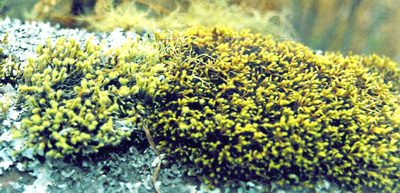
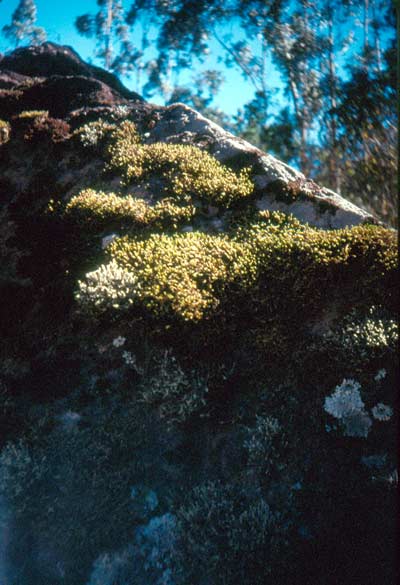
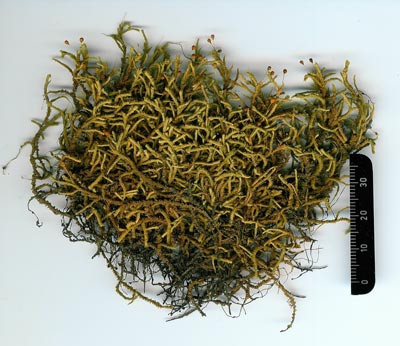
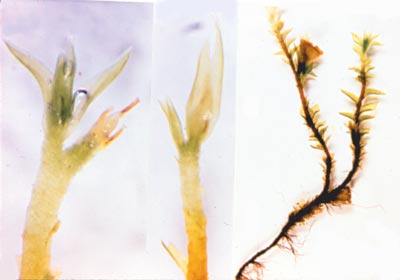
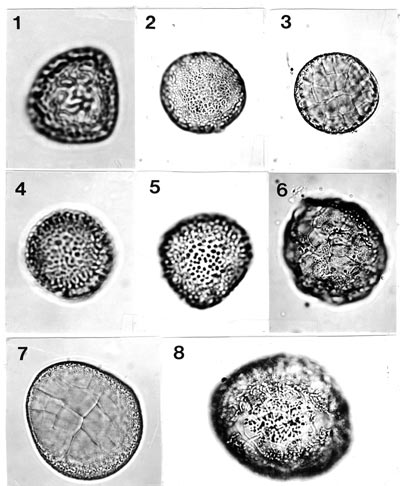 Spore variation in Hedwigiaceae
Spore variation in Hedwigiaceae
